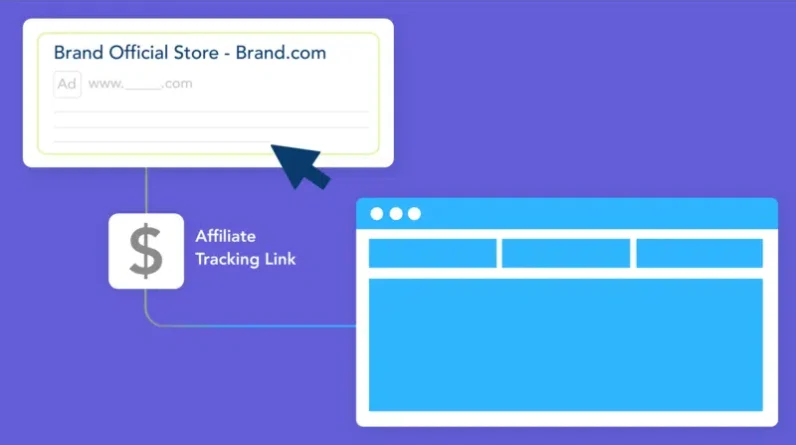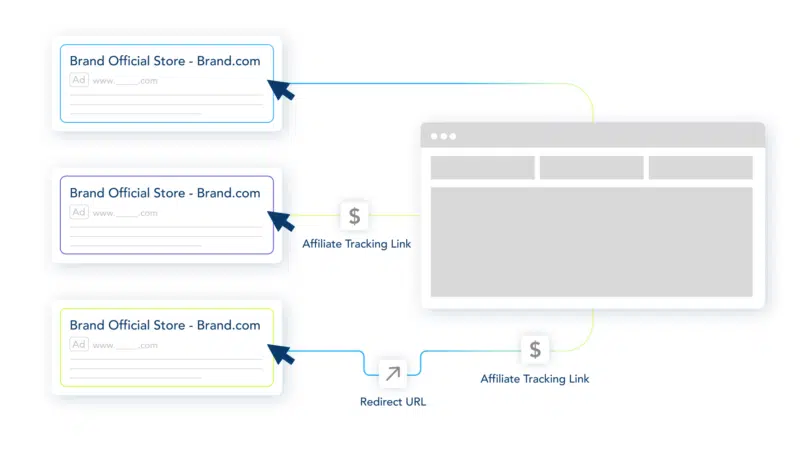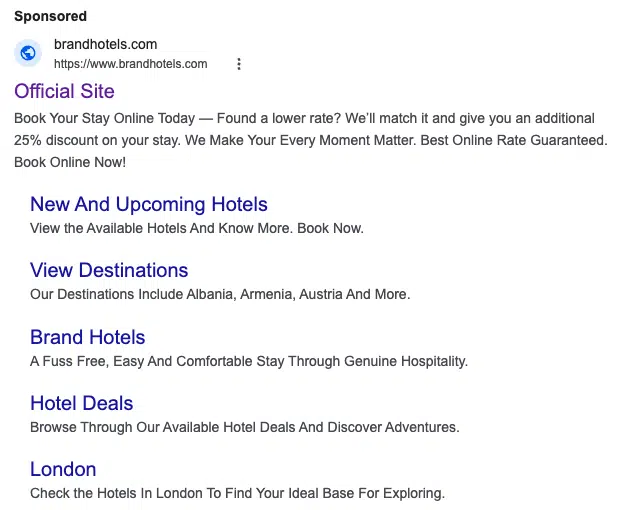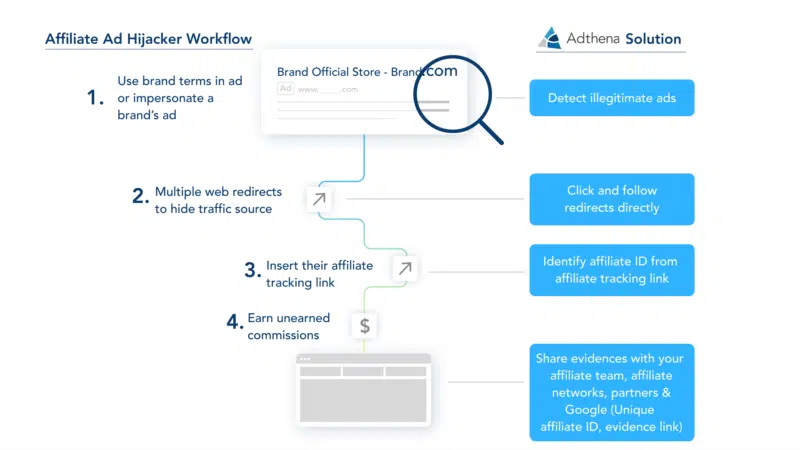
Have you ever clicked on a brand ad and ended up on a website you didn’t expect? This is ad hijacking. And it hurts advertisers and users.
Read on to learn how ad hijacking works, the risks involved, and how to protect your brand.
What is ad hijacking?
Ad hijacking is when an affiliate mimics a brand’s ads to steal clicks and revenue from their trademarked keywords. Affiliates do this to trick you into clicking their ad instead of a real one from the brand.
How does ad hijacking work?
Imagine what you are looking for [your favorite clothing brand]. Typically, the first ad you see should be the official brand, which will take you directly to their website. Here’s how ad hijacking alters this:

The rightful owner: The first ad above belongs to the brand. It leads directly to your own website using the correct tracking link.
The obvious culprit: The second ad is from an affiliate. It redirects you to the brand’s website, but adds the affiliate tracking link in the process. This allows them to steal a commission for any sale you might make, even though you intended to visit the brand directly.
The Masked Marauder: The third ad shows a more sophisticated hijacker using a series of redirects to hide its involvement. They may even send you through several websites before finally landing you on the brand’s site. This makes it difficult to identify them and hurts the brand’s affiliate program because it is difficult to track where the stolen commission is coming from.
What does ad hijacking look like?

In this example, an instance of trademark infringement has been caught using Adthena Ad Hijack Detection for a hotel brand (brand name has been changed for anonymity). A search for “brandhotels.com” returned the displayed ad, which includes the brand name in the display URL and sitelinks.
However, the ad has not been placed by the hotel brand. Placed by an affiliate offer on “brandhotels.com”.
Why is ad hijacking bad for your brand?
Ad hijacking can harm both advertisers and users. Here’s a breakdown of the main challenges it can cause:
For advertisers:
Loss of sales and income: Imagine paying for clicks that don’t reach your website! Hijacked ads steal clicks intended for your official ads, diverting potential customers and reducing sales.
Increased costs: Advertisers compete with hijackers who bid on their brand terms (ie your brand). This increases your CPC, meaning you pay more for each person who sees your actual ad.
Channel contention and data distortion: If you and a hijacker both use affiliate programs, things get messy. Metrics like impression share and revenue attribution become inaccurate, making it difficult to track campaign performance effectively.
Damage to brand reputation: If users click on a hijacked ad and end up on a low-quality website or experience something negative, it reflects poorly on your brand. They might associate the bad experience with your company.
For users:
Cheating: The purpose of ad hijacking is to trick users. They click on an ad believing it leads to a brand’s website, only to find themselves somewhere else. This may seem misleading and a waste of time.
Malware Exposure: In some cases, hijacked ads can lead to malicious websites that contain malware. This software can steal personal information or damage your device.
Time lost: Users expecting to visit a brand’s website after clicking on an ad will be disappointed if they land on an irrelevant page. They will waste valuable time browsing away from the wrong website.
Detect and stop ad hijacking attempts
Catching ad hijacking can be tricky, but there are tools to help.
Adthena Ad Hijack Detection capture instances of ad hijacking from over 50 affiliate networks and subnets by:
Constant monitoring of your brand: Ad hijack detection continuously scans search results for ads that contain your brand terms, trademarks, and even variations of them. Act as a tireless vigilante of imposters!
Identification of suspicious activities: Sophisticated algorithms analyze ad copy, landing pages and affiliate links. If something doesn’t seem genuine, it will be flagged for further investigation.
Alerts and reports: Get an immediate notification if potential hijacking attempts are detected. These reports will include details such as the offending ad copy, landing page URLs, and even suspicious affiliates involved.
Collection of evidence for withdrawal: Having all the evidence in one place makes it easier to report the offending ad to Google. You will have the affiliate ID and other necessary details for a quick withdrawal.

See ad hijack detection in action on a guided tour of the platform. To start.
How to detect ad hijacking in your campaigns
Being proactive is key to fighting ad hijacking. Here are some red flags to look out for in your brand ad campaigns:
Performance reduction: A sudden drop in clicks and conversions for your brand ads could be a sign that hijacked ads are stealing your clicks.
Suspicious spikes in affiliates: An increase in referral traffic or conversions from an unknown affiliate is cause for concern.
Copy Conversions: If an affiliate’s conversion rates mirror your brand ad campaigns suspiciously, they may be benefiting from hijacked clicks.
URL inconsistencies: Always check the landing page URLs linked to your affiliates. If they don’t match your brand’s domain or contain strange redirects, it could be a hijack attempt.
These warning signs can help you spot ad hijacking early and take steps to protect your brand.
Avoid ad hijacking before it arrives
Why wait for trouble? By being vigilant and closely monitoring your campaigns, you can take steps to identify and address ad hijacking attempts by affiliates.
1. Secure your brand identity:
Trademark protection: Register your trademarks and brand terms. This strengthens your legal position if you have to confront kidnappers.
Brand watch: Use brand tracking tools to track online mentions, including search results. This helps you spot potential hijacking attempts early on.
2. Manage your affiliate program:
Clear Affiliate Agreements: Describe acceptable practices in your affiliate agreements. Prohibit affiliates from bidding on your brand terms or using misleading ad copy.
Performance tracking: Regularly monitor the performance of your affiliate program. Look for unusual spikes in traffic or conversions from specific affiliates.
3. Paid Search Defense:
Negative keywords: Use negative keywords to prevent your ads from showing in searches that include hijacked terms or variations of your brand name.
Offer of trademarks: Consider trademarking bids for your branded keywords. This ensures that your ads appear prominently in search results, pushing hijacked ads down the page.
4. Advanced protection solutions:
Brand protection: Explore advanced brand protection tools like Adthena Ad Hijack Detection, part of the Brand protection solution These tools actively look for hijacking attempts and provide detailed reports to help you take action.

Learn more about PPC brand protection and how to do it on the page complete guide to PPC brand protection.
5. Take action:
Report offending ads: Please report any instances of ad hijacking to the relevant search engine platform.
Cancel malicious affiliates: If you identify any affiliates that engage in ad hijacking, terminate their agreements immediately.
Fight against ad hijacking
Ad hijacking can be stealthy, stealing clicks and damaging your brand’s reputation. By understanding how it works, you can take proactive steps to:
Protect your brand: Register trademarks and use brand monitoring tools to stay alert to hijacking attempts.
Secure your affiliate program: Define acceptable practices in affiliation agreements. Prevent affiliates from bidding on your brand terms or using misleading ad copy.
Place paid search protection: Use negative keywords to prevent hijacked terms from triggering your ads. Consider trademark bidding to ensure your ads appear prominently.
Consider advanced protection: Explore tools like Adthena Ad Hijack Detection for advanced monitoring and defense.
Remove hijackers: Report offending ads to search engines and end relationships with rogue affiliates.
By staying informed and implementing these strategies, you can take back control of your online presence and ensure a positive experience for your customers.
Do you know if your brand keywords are being hijacked by your affiliates? Take a self-guided tour of Adthena’s platform Ad hijack detection or Book a demo To start.
[ad_2]
Source link




